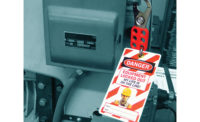8 steps to a lockout-tagout procedure
A guide to reducing accidents and eliminating hazards

Photo credit: PK Safety
The lockout-tagout (LOTO) procedure is standard company policy for restricting employee access to equipment that can potentially generate electricity, hazardous energies, or other dangers that come with routine maintenance, installation and inspection. Locking out the equipment prevents others from accidentally turning on the equipment while the repairs are being performed to reduce the rate of accidents and injuries. Use this guide to develop an effective lockout-tagout process for your worksite.
1. Shutdown preparation
Everyone occupying the worksite should be trained on proper LOTO procedures as well as the potential hazards present within the space. Educating employees is the first step to a successful repair job.
2. Notify employees
All workers whose jobs will be affected by the LOTO should be notified of the planned outage ahead of time, including which pieces of equipment will be taken offline and for how long. If the employees need to use the equipment for work, they should be given alternate tasks or responsibilities.
3. Shut down the energy source
Before making the repairs, use the appropriate shutdown procedures to turn off the equipment safely. Check the owner’s manual to learn how to turn off the equipment properly.
4. Isolate the energy source
Disconnect the underlying energy source from the equipment that needs to be maintained to further eliminate the possibility of someone accidentally turning it on while the repairs are being made. Isolate and shut off circuit breakers connected to the equipment. Turn off generators, compressors and other machines supplying energy to the equipment.
5. Lock the energy sources
Use a LOTO padlock device to physically prevent anyone from accessing and restarting the energy supply while the repairs are being made. The device blocks the switch, ignition, or circuit from being activated. It requires a key that should remain in the technician’s control and on their person at all times.
6. Release the stored energy
The LOTO prevents new energy from entering the equipment, but there could be additional energy stored in the machine. Spring tension or parts raised/suspended overhead are examples of indirect stored energy. Make sure there are no moving parts or processes that could start during the repair process, such as air compressors, compactors, and sliding sleeves.
7. Verify lockout
Verify that there is no way for someone to accidentally restart the equipment while the repairs are being performed. Test the equipment to see if it starts and to ensure the lockout is successful.
8. Maintain lockout
Keep the equipment offline and disconnected from the power source until the repairs are complete. The LOTO device must remain in place throughout the process. Remove unrelated workers from the repair site and communicate with incoming workers during the shift change to inform them of the situation at hand. Post visual reminders and set up barriers to reduce access to the affected area.
These steps are designed to help workers and repair technicians do their jobs safely in the field. The equipment in question must be completely drained of its power and disconnected from external energy sources and the electrical grid before the work begins.
Looking for a reprint of this article?
From high-res PDFs to custom plaques, order your copy today!









